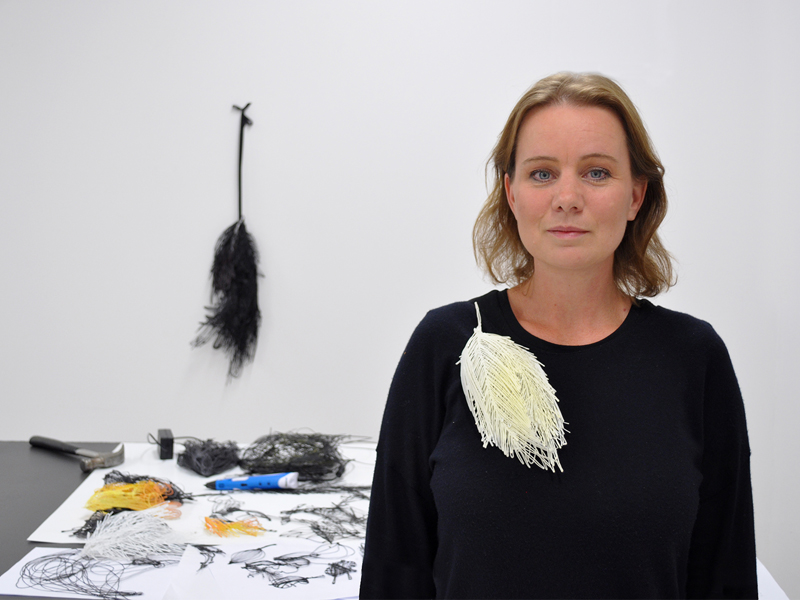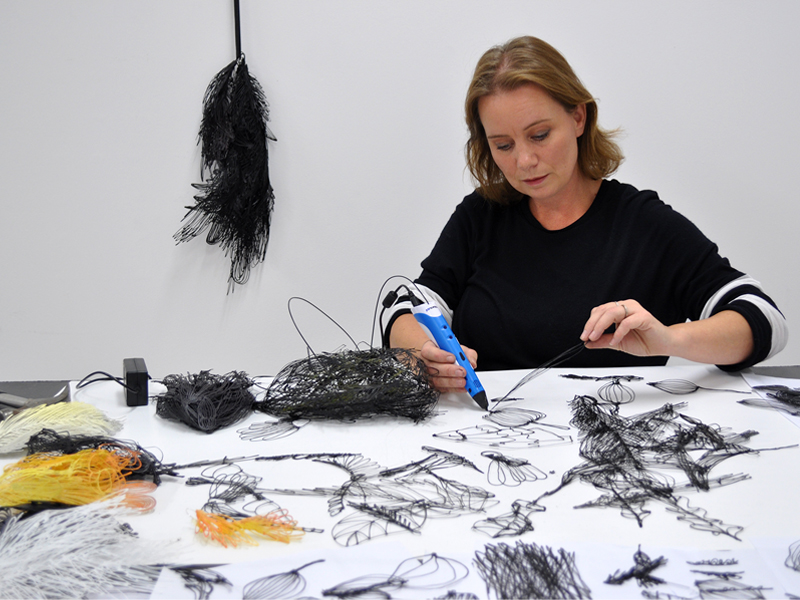
Sofia Björkman is a contemporary jewelry phenomenon and an example for us all. She is a trained artist, a self-taught gallery owner, a creative mother, and open to it all. How does one woman pack so much into each day? Her show with Galeria Thomas Cohn in Brazil gave her an opportunity to answer questions about all three.
Susan Cummins: Sofia, you are incredibly busy. Not only are you a jeweler doing some amazing new work, but you also own Platina gallery in Stockholm and are a mother. In this show at the Galeria Thomas Cohn, I understand you are showing both your own work and also acting as a dealer by showing a number of jewelers you represent. Is that correct? If so, how did this collaboration come about?
Sofia Björkman: Before, I thought it was important to separate private life, parenthood, the gallery, and my own artistic practice, but I am not doing that any longer. I am one person doing different things and the multifaceted elements feed rather than diminish each other. Everything is entwined. When people invite me to show, they normally invite me just because of my complex practice. I am busy and fortunately I live in one of the most equal countries in the world. Sweden is not completely equal, but my children’s father and I split 50% of the childcare.
Thomas Cohn and I started to talk and he invited me to Saõ Paulo to do a show, with my own work, but also because of my other activities and knowledge in the field. It turned out to be two shows in one, a solo by me and a group by me as a curator.
![[left] Sofia Björkman, From the series: What has the bird done?, 2015, neckpiece, PLA, silver, paint, 660 x 260 x 80 mm, photo: Urban Jörén [right] Sofia Björkman, From the series: What has the bird done?, 2015, brooch, PLA, silver, paint, 330 x 180 x 90 mm, photo: artist [left] Sofia Björkman, From the series: What has the bird done?, 2015, neckpiece, PLA, silver, paint, 660 x 260 x 80 mm, photo: Urban Jörén [right] Sofia Björkman, From the series: What has the bird done?, 2015, brooch, PLA, silver, paint, 330 x 180 x 90 mm, photo: artist](/sites/default/files/int_sofia_bjorkman_1_5_600x800px.jpg)
First let’s talk about you as a jeweler. Your work has suddenly become very large and airy, like a bird in flight or a bundle of twigs. What or who is your inspiration for this work?
Sofia Björkman: I am aware that my work is shifting, but actually it is also going around in circles. I have worked before with an even larger scale, lightness, birds and twigs. At the beginning of the millennium, I was sawing metal sheets like crazy to tell stories and make wonderlands that included birds, butterflies, horses, lions, jungles, and more. When I started this new series, I had a conversation about wildness from which I wrote the introduction: “I told a friend that I find it difficult to make something that looks wild and he replied: ‘I went out to look for horns, and when I came back I found everything in a mess. I wonder what the bird has done.’”
Bundles of twigs and branches have followed me for a while. Humans and animals make them for a purpose but to me they look wild. There was a big bundle of branches near where I was born. Around the 12th century, there was a woman who got stoned to death there and people still throw branches at the spot. There are several versions of the story, which talks about prejudices through history. Wildness, wild behavior, and wilderness have occupied me during the last year. Any attempt to describe the wildness conceals infinitely more than it reveals.
In Saõ Paulo, I gave a workshop through ateliê MMK (Miriam Mirna Korolkovas) on the theme of wilderness, and the Brazilian artists shared their thoughts by making, performing, and speaking.
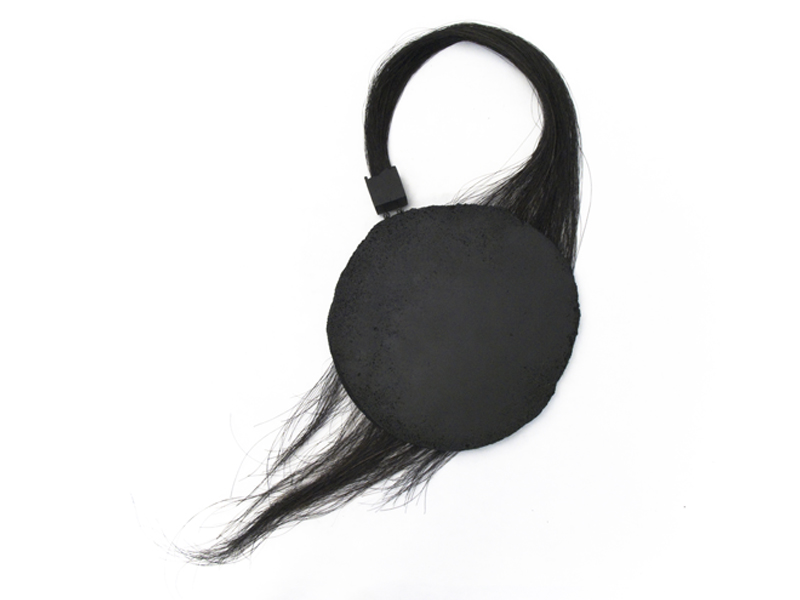
How do you make the new pieces? Where did you find the technique?
Sofia Björkman: A while ago I got a three-dimensional pen as a birthday gift. It took me a while to figure out how to work with it. I had some days off during a vacation recently and started to make three-dimensional drawings with it. I got hooked and worked like crazy the whole vacation through. The material is PLA (polylactic acid), an organic plastic material made of cornstarch, which I explored in another project with a totally different outcome. So the techniques and ideas I use come and go. I melt the material with the pen, make the drawing, and then shortly after it gets hard again.
Next I want to ask you about collaborating as a gallery. You have collaborated with AJF in Munich to show the AJF Artist Award finalists, and now you are working with Galeria Thomas Cohn in Brazil. I believe you have done other projects as well. What are the pros and cons of doing this kind of work?
Sofia Björkman: I love people and I am interested in what others do. During my education, I learned about individualistic artistic practices. Studio work can be very lonely and often includes too much navel-gazing. To work with others is for me a way of understanding how others look upon life. And, yes, I am very open for different kinds of collaborations. Mostly I find it a win-win. Thomas Cohn took a brave and interesting turn in his career by starting to work with jewelry after he had been working with art for many years. He has a lot of great knowledge to share from his many experiences working within the art world. We discussed, we shared experiences, and we helped each other. Along with some others, Thomas is putting Brazil on the international jewelry map and is open for further collaborations between artists and dealers around the world. These kinds of activities interest me.
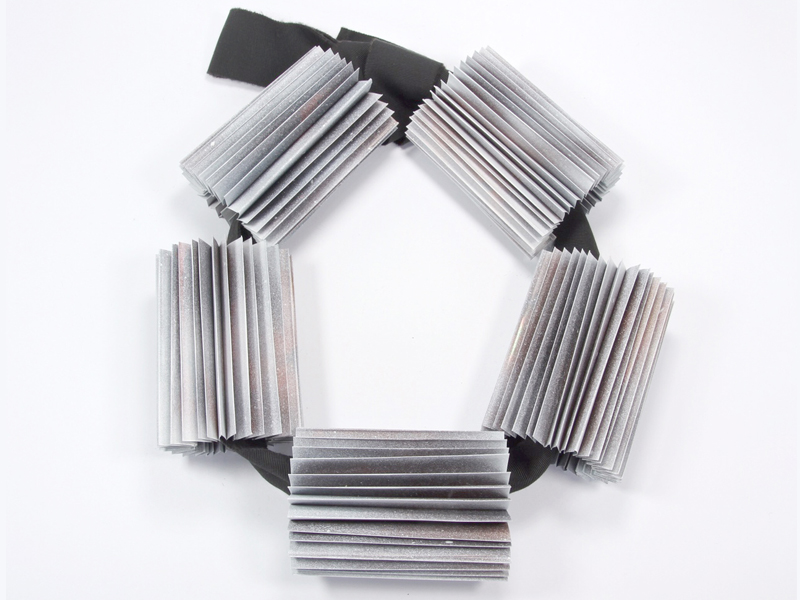
Which of your artists did you bring, and what were you thinking when you decided to bring their jewelry in particular?
Sofia Björkman: I brought jewelry from Adam Grinovich, Aud Charlotte, Ho Sook Sinding, Heejoo Kim, Seulgi Kwon, Li Lang, Agnes Larsson, Helena Lehtinen, Asa Lockner, Annika Pettersson, Margareth Sandström, and Sanna Svedestedt, and photography of my work by Urban Jörén.
I listened to what Thomas was interested in and our final selection was a collaborative effort. It is a selection from Platina, but most of the work comes from artists based in Sweden. The selection includes artists who have been part of the focus of the gallery in recent years, artists who have made new works, and artists who work in materials that are difficult to photograph or are of interest for other reasons. There are works that differ from each other and at same time work together as a group. There are also practical things to think of when traveling so far with jewelry. Those include the economic value, the transportability, non-problematic materials, and things like that.
Were you able to see the reaction of the Brazilian clients to the work you brought?
Sofia Björkman: The opening was great, many more people came than I expected. I had more work of my own than we could display and so we let artists and clients walk around wearing it. The most common reaction was about the weight of the material. The pieces are big but they are very light, which works for thin clothes made for a hot climate. It is difficult to imagine the true intimacy and sensorial elements of jewelry by looking at photos of it in books or on the Internet. I think the value of each piece increases when someone can put the pieces on or explore them with their senses. And of course there are works made of transformed material that are fascinating to explore in real life, like the work from Seulgi Kwon, Agnes Larsson, Heejoo Kim, Aud Charlotte, and Ho Sook Sinding. A lot of Brazilians, especially the artists, can’t afford to travel very often, so it was good to be able to show them the pieces in person.
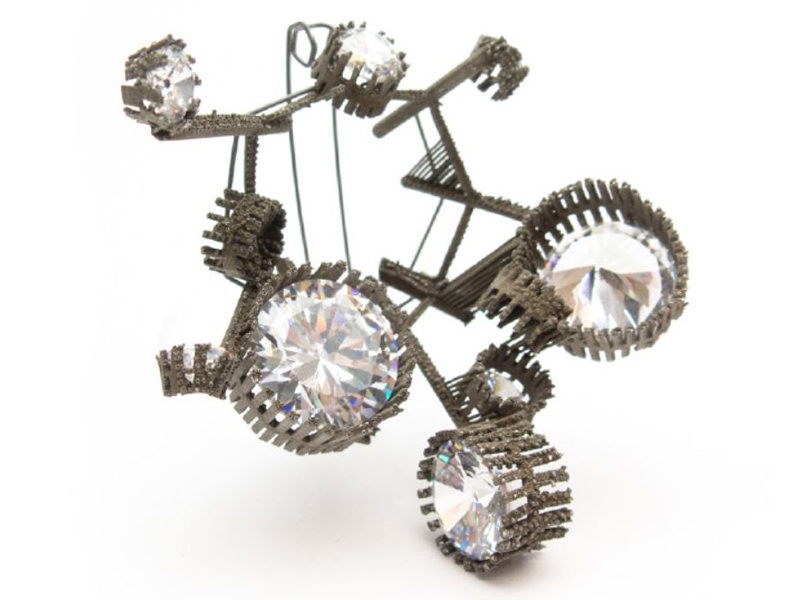
Did you have the chance to see Brazilian jewelry? If so, what did you think of it? Was there an artist or two you would consider showing in your gallery in Stockholm?
Sofia Björkman: I saw some, but not as much I was hoping for. Some jewelers showed me their work, and Miriam Mirna Korolkovas was kind enough to take me around to studios. I was very happy about that. Culture, history, religion, local materials, politics, schools, and environments play major roles in the outcome. Although there are global similarities, there were references to backgrounds and symbolism, which I don’t understand as a foreigner, but that contain a lot that is familiar and understood by them. I spent some time with Miriam, who many from outside Brazil know. But she has also been in the US (awarded a visiting professor scholarship by the Fulbright Commission/CAPES at University of Michigan—School of Art & Design, MFA at Pratt Institute), and has traveled around and taken her work outside Brazil.
It was interesting to get the chance to collaborate with Thomas Cohn and Miriam Mirna Korolkovas, and to meet some artists based there. I hope it will open up things for further cooperation. We have a lot to give each other, in different ways, I think.

And last but not least—how many children do you have, and how old are they? Do you have any children’s books or movies to recommend?
Sofia Björkman: I have two daughters; they’re eight and nine years old. Even if I am a workaholic, I spend a lot of time with them. We read, watch movies, and play together. The Pippi Longstocking book by Astrid Lindgren and the movie that followed are the ones I can recommend. Pippi is such a great hero, both for children and adults, and can be read and seen over and over again. I also recommend playing with children. It may sound like a cliché to say that they have added a lot to my artistic practice, but it is true. I was playing with them the first time I made something out of corn starch and found its potential as a material. And I have also been playing with them and made things out of packaging material—PLA. PLA, which I used for the series shown at Thomas Cohn, is also used for 3D printing. Amazing material, and it is organic!
Thank you.
